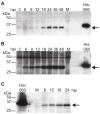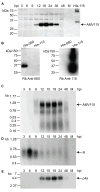An Amsacta moorei entomopoxvirus ortholog of the poly(A) polymerase small subunit exhibits methyltransferase activity and is non-essential for virus growth
- PMID: 18367228
- PMCID: PMC2478561
- DOI: 10.1016/j.virol.2008.02.023
An Amsacta moorei entomopoxvirus ortholog of the poly(A) polymerase small subunit exhibits methyltransferase activity and is non-essential for virus growth
Abstract
Unlike the heterodimeric poly(A) polymerase (PAP) of vaccinia virus (VACV), the PAP from the Amsacta moorei entomopoxvirus, AMEV, is potentially derived from three subunits: a single large and two small subunits (AMV060 and AMV115). The VACV small subunit serves as a 2'-O-methyltransferase, a processivity factor for mRNA polyadenylation, and a transcription elongation factor. We wished to determine the structure-function relationships of the three putative AMEV PAP subunits. We show that AMV060 is expressed as an early gene persisting throughout infection, whereas AMV115 is expressed late. We demonstrate that AMV060 exhibits 2'-O-methyltransferase activity but the gene is not essential for virus growth. Absence of the AMV060 protein has no effect on the length of the poly(A) tails present in mRNA. No physical association was found between any of the putative AMEV PAP subunits. We therefore propose that mRNA polyadenylation does not require interactions between these three proteins.
Figures










Similar articles
-
The protein-protein interactions between Amsacta moorei entomopoxvirus (AMEV) protein kinases (PKs) and all viral proteins.Virus Res. 2018 Mar 15;248:31-38. doi: 10.1016/j.virusres.2018.02.007. Epub 2018 Feb 19. Virus Res. 2018. PMID: 29471050
-
Transcriptional analysis of the putative glycosyltransferase gene (amv248) of the Amsacta moorei entomopoxvirus.Virus Res. 2018 Jan 2;243:25-30. doi: 10.1016/j.virusres.2017.10.006. Epub 2017 Oct 8. Virus Res. 2018. PMID: 29020603
-
Amsacta moorei entomopoxvirus encodes a functional DNA photolyase (AMV025).J Invertebr Pathol. 2010 Nov;105(3):363-5. doi: 10.1016/j.jip.2010.06.013. Epub 2010 Jul 1. J Invertebr Pathol. 2010. PMID: 20600091
-
Amsacta moorei entomopoxvirus encodes a functional esterase (amv133) with protease activity.Intervirology. 2015;58(1):41-8. doi: 10.1159/000369018. Epub 2015 Jan 15. Intervirology. 2015. PMID: 25591507
-
Evolution of viral DNA-dependent RNA polymerases.Virus Genes. 1995;11(2-3):271-84. doi: 10.1007/BF01728665. Virus Genes. 1995. PMID: 8828152 Review.
Cited by
-
Functional and computational identification of a rescue mutation near the active site of an mRNA methyltransferase.Sci Rep. 2020 Dec 14;10(1):21841. doi: 10.1038/s41598-020-79026-2. Sci Rep. 2020. PMID: 33318548 Free PMC article.
References
-
- Barbosa E, Moss B. mRNA(nucleoside-2′-)-methyltransferase from vaccinia virus. Purification and physical properties. J Biol Chem. 1978;253:7692–7697. - PubMed
-
- Bawden AL, Glassberg KJ, Diggans J, Shaw R, Farmerie W, Moyer RW. Complete genomic sequence of the Amsacta moorei entomopoxvirus: analysis and comparison with other poxviruses. Virology. 2000;274:120–139. - PubMed
-
- Becker MN, Moyer RW. Subfamily Entomopoxvirinae. In: Mercer A, Schmidt A, Weber O, editors. Poxviruses. Birkhäuser Publishing; Basel: 2007.
Publication types
MeSH terms
Substances
Grants and funding
LinkOut - more resources
Full Text Sources
Research Materials

